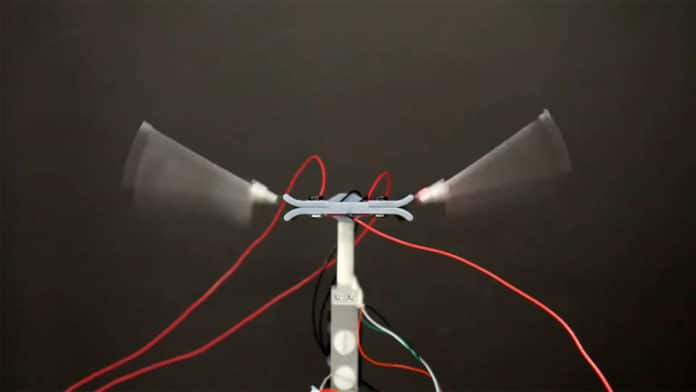Micro flying robots, whether they use wings or propellers, can access a wide range of locations, including confined spaces such as the inside of industrial plants and collapsed buildings, and offer high maneuverability and tolerance to disturbances. However, most current flying robots use motors, gears, and other complex transmission systems to achieve the up-and-down motion of the wings. This has added complexity, weight, and undesired dynamic effects.
Now taking inspiration from bees and other flying insects, engineers at the University of Bristol have developed a small flying robot that can flap its wings more efficiently than an insect, thanks to the new method of electromechanical zipping. The new robot uses an artificial muscle system, called the Liquid-amplified Zipping Actuator (LAZA), for flapping-wing autonomous robots that achieve wing motion using no rotating parts or gears. The LAZA system greatly simplifies the flapping mechanism, enabling future miniaturization of flapping robots down to the size of insects.
The system induces wing movement by direct application of liquid-amplified electrostatic forces at the wing root. Each wing is made up of an electrode sticking out from between two other smaller electrodes at the base. The application of high voltage induces time-varying electrostatic forces directly at the wing root, generating controllable flapping movement of the ring electrode.
According to the researchers, a pair of LAZA-powdered flapping wings can provide more power compared with insect muscle of the same weight, enough to fly a robot across a room at 18 body lengths per second (2.5 km/h). They also demonstrated how the LAZA could deliver consistent flapping over more than one million cycles, which is important for making flapping robots that can undertake long-haul flights.
“With the LAZA, we apply electrostatic forces directly on the wing, rather than through a complex, inefficient transmission system. This leads to better performance, simpler design and will unlock a new class of low-cost, lightweight flapping micro-air vehicles for future applications, like autonomous inspection of offshore wind turbines,” said Dr. Tim Helps, lead author and developer of the LAZA system.
This new advance could pave the way for smaller, lighter, and more effective micro flying robots for environmental monitoring, search and rescue, and deployment in hazardous environments.
